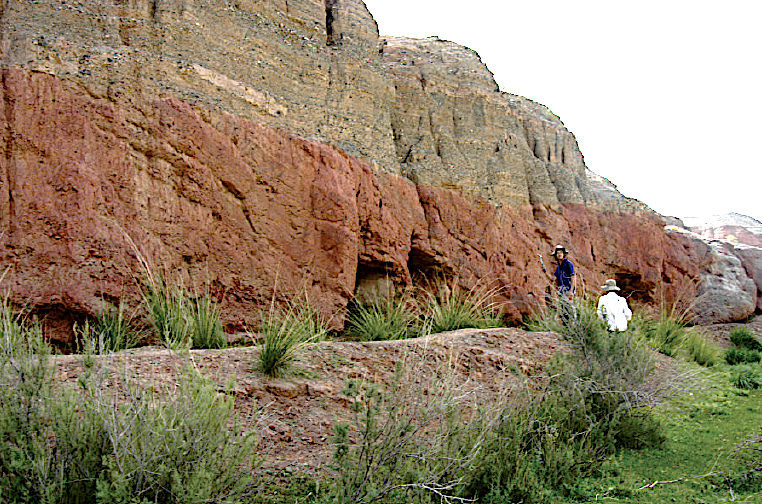Zhonggou Fm
Type Locality and Naming
Jiuquan Basin, Beishan. The Zhonggou Formation was erected by the Gansu Regional Geological Survey Team in 1976. The section for the designation is on the east side of Xiagou of Qingquan township of the Yumen City of Gansu (97°48′E; 39°36′40″N). Highest formation in Xinminpu Gr.
Lithology and Thickness
Lower part of the Zhonggou Formation is represented by purple red thick-bedded conglomerate with clayey siltstone. Upper part is purple red, gray green and yellow brown variegated conglomerate, arkose with clayey siltstone and mudstone. The Zhonggou Formation is 1110.5 m thick.
[Figure: Zhonggou Formation in Xinminbao section of northern Qilian Mountain, Gansu]
[Figure: Zhonggou Formation in Changma section of northern Qilian Mountain, Gansu]
Relationships and Distribution
Lower contact
The base of the formation marked by greatly thick-bedded purple red conglomerate is distinguished from the Xiagou Fm marked by gray green conglomerate with clayey siltstone, showing a conformable contact with the latter.
Upper contact
The top marked by flesh-colored and yellow brown conglomerate and sandstone with gray green clayey siltstone lies unconformably under the overlying Quaternary Pleistocene Jiuquan Fm. It may also be overlain by the Paleogene Huoshaogou Fm. Regionally, next younger unit is the Xinminpu Gr
Regional extent
The occurrence of present formation is similar to the Xiagou Fm. It is basically the same in lithology throughout Gansu, and decreases in thickness from east to west in Xiagou. In the Hongliuxia area, it is represented by brown red and tangerine red conglomerate with gravel-bearing silty mudstone and yellow green sandstone, measuring 74.7 m in thickness. At the mouth of Hanxia, it is built up by gray green and gray yellow conglomerate interbedded with gray green and brown red sandy mudstone, sandstone and shale of different thicknesses, measuring 189 m in thickness. In the Beishan area at the juncture between Gansu and the Inner Mongolia, it is dominated by break red and purple red conglomerate and gravel-bearing sandstone, with a thickness of more than 231 m.
GeoJSON
Fossils
The formation yields gastropods Probaicalia gerassimovi, Viviparus sp. and bivalves; on the section on the west side of Xiagou, ostracods Lycopterocypris infantilis, Cypridea latiovata; bivalves Nakamuranaia chingshanensis, Tolypella stipitata, gastropods, insects and floras; it also yields estherias Neodiestheria dalaziensis, Yanjiestheria yumensis, Y. sinensis; ostracods Candonachijinshiaensis, Cypridea (Cypridea) sinensis; Fish Oilianichthys changmaensis, Changtna shenjawanensis; insects Eurycoleus parvus, Glyptocoleus stellatus, Mesocoleus zhonggouensis, Mesoblattina cretacea, Yumenocoleus spinusyujensis; floras Ruffordia goepperti, Brachyphyllum japonicm, Elatides cuvifolia, Otozamites sp.; sporopollen grains Cicatricosisporites, Classopollis, Clavatipollenites, Retircolpites, etc.
Age
Depositional setting
It belongs to piedmont-fluvial deposition.
Additional Information

